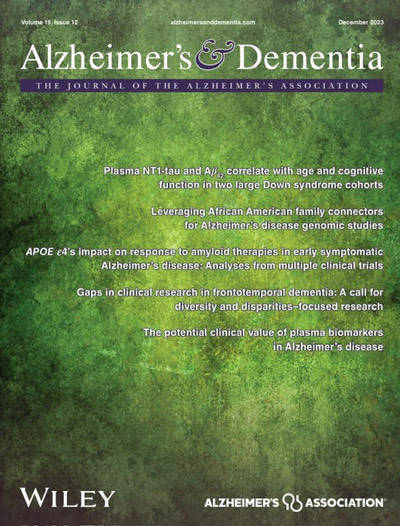Cognition Four Decades After High School: Does School Context Matter for Cognitive Disparities at Midlife?
IF 13
1区 医学
Q1 CLINICAL NEUROLOGY
引用次数: 0
Abstract
BackgroundStructural racism shapes educational quality by perpetuating unequal access to school resources, creating disproportionate exposure to disciplinary actions, and limiting access to advanced courses among racially minoritized children. School quality is linked to later life ADRD risk, but the benefit may vary across groups. We asked 1) whether the same high school social contexts and academic resources predict midlife cognitive functioning across race, ethnicity, and gender, and 2) how much could disparities in midlife cognitive function be narrowed if everyone had equal access to high quality high schools?MethodData was from the nationally representative High School and Beyond cohort, which prospectively followed 12,530 Americans from high school through age ∼60 and administered telephone‐ and web‐based measures of memory, language, and attention in 2021‐22. Extensive information about family, high school social and academic context, and student achievements was gathered directly from students and their schools in 1980‐1982. OLS regression models estimated associations between specific school variables and an IRT‐derived cognitive composite, before and after adjustment for confounders in race, ethnicity, and sex stratified models.ResultHigher average SES of students in each high school predicted better midlife cognitive test scores among White people and Latina women, but not among Latino men or Black participants. This association weakened after adding school academic context variables. A composite measure capturing school‐level academic engagement and rigor (academic press) predicted better cognition among White and Latinx participants but not among Black participants. If everyone had access to high schools of the same quality as the group with the highest test scores (White women), and adjusting for family confounders, disparities between White women and participants from racially minoritized groups would be substantially reduced (by 9% among Black women, 5% among Black men, and 6% among Latino men and Latina women).ConclusionInvestment in high schools that serve Black and Latinx children could meaningfully narrow disparities in cognition four decades later, particularly among Black women. Later life cognitive benefit of specific aspects of school context, such as high SES peers and academic rigor, had differential benefit depending on race, ethnicity, and sex.高中四十年后的认知:学校环境对中年认知差异有影响吗?
结构性种族主义使获得学校资源的机会永远不平等,造成不成比例的纪律处分,并限制少数族裔儿童获得高级课程的机会,从而影响了教育质量。学校质量与以后生活中的ADRD风险有关,但益处可能因群体而异。我们的问题是:(1)相同的高中社会背景和学术资源是否可以预测跨种族、民族和性别的中年认知功能;(2)如果每个人都有平等的机会进入高质量的高中,中年认知功能的差异可以缩小多少?方法数据来自具有全国代表性的高中及以上队列,该队列前瞻性地跟踪了12,530名从高中到60岁的美国人,并在2021 - 2022年进行了基于电话和网络的记忆、语言和注意力测量。在1980 - 1982年期间,直接从学生和他们的学校收集了有关家庭、高中社会和学术背景以及学生成绩的大量信息。OLS回归模型估计了在种族、民族和性别分层模型中调整混杂因素之前和之后,特定学校变量与IRT衍生的认知复合物之间的关联。结果各高中学生的平均社会经济地位越高,白人和拉丁裔女性的中年认知测试成绩越好,而拉丁裔男性和黑人参与者的中年认知测试成绩则越好。在加入学校学术背景变量后,这种关联减弱。捕获学校水平的学术参与和严谨性(学术出版)的综合测量预测白人和拉丁裔参与者的认知更好,而黑人参与者则没有。如果每个人都能进入与考试成绩最高的群体(白人女性)同样质量的高中,并根据家庭混杂因素进行调整,白人女性和少数族裔参与者之间的差异将大大减少(黑人女性减少9%,黑人男性减少5%,拉丁裔男性和拉丁裔女性减少6%)。结论:在为黑人和拉丁裔儿童服务的高中进行投资,可以在40年后缩小认知方面的差距,尤其是在黑人女性之间。学校环境的特定方面的晚年认知益处,如高SES同伴和学术严谨性,根据种族、民族和性别有不同的益处。
本文章由计算机程序翻译,如有差异,请以英文原文为准。
求助全文
约1分钟内获得全文
求助全文
来源期刊

Alzheimer's & Dementia
医学-临床神经学
CiteScore
14.50
自引率
5.00%
发文量
299
审稿时长
3 months
期刊介绍:
Alzheimer's & Dementia is a peer-reviewed journal that aims to bridge knowledge gaps in dementia research by covering the entire spectrum, from basic science to clinical trials to social and behavioral investigations. It provides a platform for rapid communication of new findings and ideas, optimal translation of research into practical applications, increasing knowledge across diverse disciplines for early detection, diagnosis, and intervention, and identifying promising new research directions. In July 2008, Alzheimer's & Dementia was accepted for indexing by MEDLINE, recognizing its scientific merit and contribution to Alzheimer's research.
 求助内容:
求助内容: 应助结果提醒方式:
应助结果提醒方式:


